1
2
3
4
5
6
7
8
9
10
11
12
13
14
15
16
17
18
19
20
21
22
23
24
25
26
27
28
29
30
31
32
33
34
35
36
37
38
39
40
41
42
43
44
45
46
47
48
49
50
51
52
53
54
55
56
57
58
59
60
61
62
63
64
65
66
67
68
69
70
71
72
73
74
75
76
77
78
79
80
81
82
83
84
85
86
87
88
89
90
91
92
93
94
95
96
97
98
99
100
101
102
103
104
105
106
107
108
109
110
111
112
113
114
115
116
117
118
119
120
121
122
123
124
125
126
127
128
129
130
131
132
133
134
135
136
137
138
139
140
141
142
143
144
145
146
147
148
149
150
151
152
153
154
155
156
157
158
159
160
161
162
163
164
165
166
167
168
169
170
171
172
173
174
175
176
177
178
179
180
181
182
183
184
185
186
187
188
189
190
191
192
193
194
195
196
197
198
199
200
201
202
203
204
205
206
207
208
209
210
211
212
213
214
215
216
217
218
219
220
221
222
223
224
225
226
227
228
229
230
231
232
233
234
235
236
237
238
239
240
241
242
243
244
245
246
|
# Kubernetes monitoring with Netdata
This document gives an overview of what visualizations Netdata provides on Kubernetes deployments.
At Netdata, we've built Kubernetes monitoring tools that add visibility without complexity while also helping you
actively troubleshoot anomalies or outages. This guide walks you through each of the visualizations and offers best
practices on how to use them to start Kubernetes monitoring in a matter of minutes, not hours or days.
Netdata's Kubernetes monitoring solution uses a handful of [complementary tools and
collectors](#related-reference-documentation) for peeling back the many complex layers of a Kubernetes cluster,
_entirely for free_. These methods work together to give you every metric you need to troubleshoot performance or
availability issues across your Kubernetes infrastructure.
## Challenge
While Kubernetes (k8s) might simplify the way you deploy, scale, and load-balance your applications, not all clusters
come with "batteries included" when it comes to monitoring. Doubly so for a monitoring stack that helps you actively
troubleshoot issues with your cluster.
Some k8s providers, like GKE (Google Kubernetes Engine), do deploy clusters bundled with monitoring capabilities, such
as Google Stackdriver Monitoring. However, these pre-configured solutions might not offer the depth of metrics,
customization, or integration with your preferred alerting methods.
Without this visibility, it's like you built an entire house and _then_ smashed your way through the finished walls to
add windows.
## Solution
In this tutorial, you'll learn how to navigate Netdata's Kubernetes monitoring features, using
[robot-shop](https://github.com/instana/robot-shop) as an example deployment. Deploying robot-shop is purely optional.
You can also follow along with your own Kubernetes deployment if you choose. While the metrics might be different, the
navigation and best practices are the same for every cluster.
## What you need to get started
To follow this tutorial, you need:
- A free Netdata Cloud account. [Sign up](https://app.netdata.cloud/sign-up?cloudRoute=/spaces) if you don't have one
already.
- A working cluster running Kubernetes v1.9 or newer, with a Netdata deployment and connected parent/child nodes. See
our [Kubernetes deployment process](https://github.com/netdata/netdata/blob/master/packaging/installer/methods/kubernetes.md) for details on deployment and
conneting to Cloud.
- The [`kubectl`](https://kubernetes.io/docs/reference/kubectl/overview/) command line tool, within [one minor version
difference](https://kubernetes.io/docs/tasks/tools/install-kubectl/#before-you-begin) of your cluster, on an
administrative system.
- The [Helm package manager](https://helm.sh/) v3.0.0 or newer on the same administrative system.
### Install the `robot-shop` demo (optional)
Begin by downloading the robot-shop code and using `helm` to create a new deployment.
```bash
git clone git@github.com:instana/robot-shop.git
cd robot-shop/K8s/helm
kubectl create ns robot-shop
helm install robot-shop --namespace robot-shop .
```
Running `kubectl get pods` shows both the Netdata and robot-shop deployments.
```bash
kubectl get pods --all-namespaces
NAMESPACE NAME READY STATUS RESTARTS AGE
default netdata-child-29f9c 2/2 Running 0 10m
default netdata-child-8xphf 2/2 Running 0 10m
default netdata-child-jdvds 2/2 Running 0 11m
default netdata-parent-554c755b7d-qzrx4 1/1 Running 0 11m
kube-system aws-node-jnjv8 1/1 Running 0 17m
kube-system aws-node-svzdb 1/1 Running 0 17m
kube-system aws-node-ts6n2 1/1 Running 0 17m
kube-system coredns-559b5db75d-f58hp 1/1 Running 0 22h
kube-system coredns-559b5db75d-tkzj2 1/1 Running 0 22h
kube-system kube-proxy-9p9cd 1/1 Running 0 17m
kube-system kube-proxy-lt9ss 1/1 Running 0 17m
kube-system kube-proxy-n75t9 1/1 Running 0 17m
robot-shop cart-b4bbc8fff-t57js 1/1 Running 0 14m
robot-shop catalogue-8b5f66c98-mr85z 1/1 Running 0 14m
robot-shop dispatch-67d955c7d8-lnr44 1/1 Running 0 14m
robot-shop mongodb-7f65d86c-dsslc 1/1 Running 0 14m
robot-shop mysql-764c4c5fc7-kkbnf 1/1 Running 0 14m
robot-shop payment-67c87cb7d-5krxv 1/1 Running 0 14m
robot-shop rabbitmq-5bb66bb6c9-6xr5b 1/1 Running 0 14m
robot-shop ratings-94fd9c75b-42wvh 1/1 Running 0 14m
robot-shop redis-0 0/1 Pending 0 14m
robot-shop shipping-7d69cb88b-w7hpj 1/1 Running 0 14m
robot-shop user-79c445b44b-hwnm9 1/1 Running 0 14m
robot-shop web-8bb887476-lkcjx 1/1 Running 0 14m
```
## Explore Netdata's Kubernetes monitoring charts
The Netdata Helm chart deploys and enables everything you need for monitoring Kubernetes on every layer. Once you deploy
Netdata and connect your cluster's nodes, you're ready to check out the visualizations **with zero configuration**.
To get started, [sign in](https://app.netdata.cloud/sign-in?cloudRoute=/spaces) to your Netdata Cloud account. Head over
to the War Room you connected your cluster to, if not **General**.
Netdata Cloud is already visualizing your Kubernetes metrics, streamed in real-time from each node, in the
[Overview](https://github.com/netdata/netdata/blob/master/docs/cloud/visualize/overview.md):
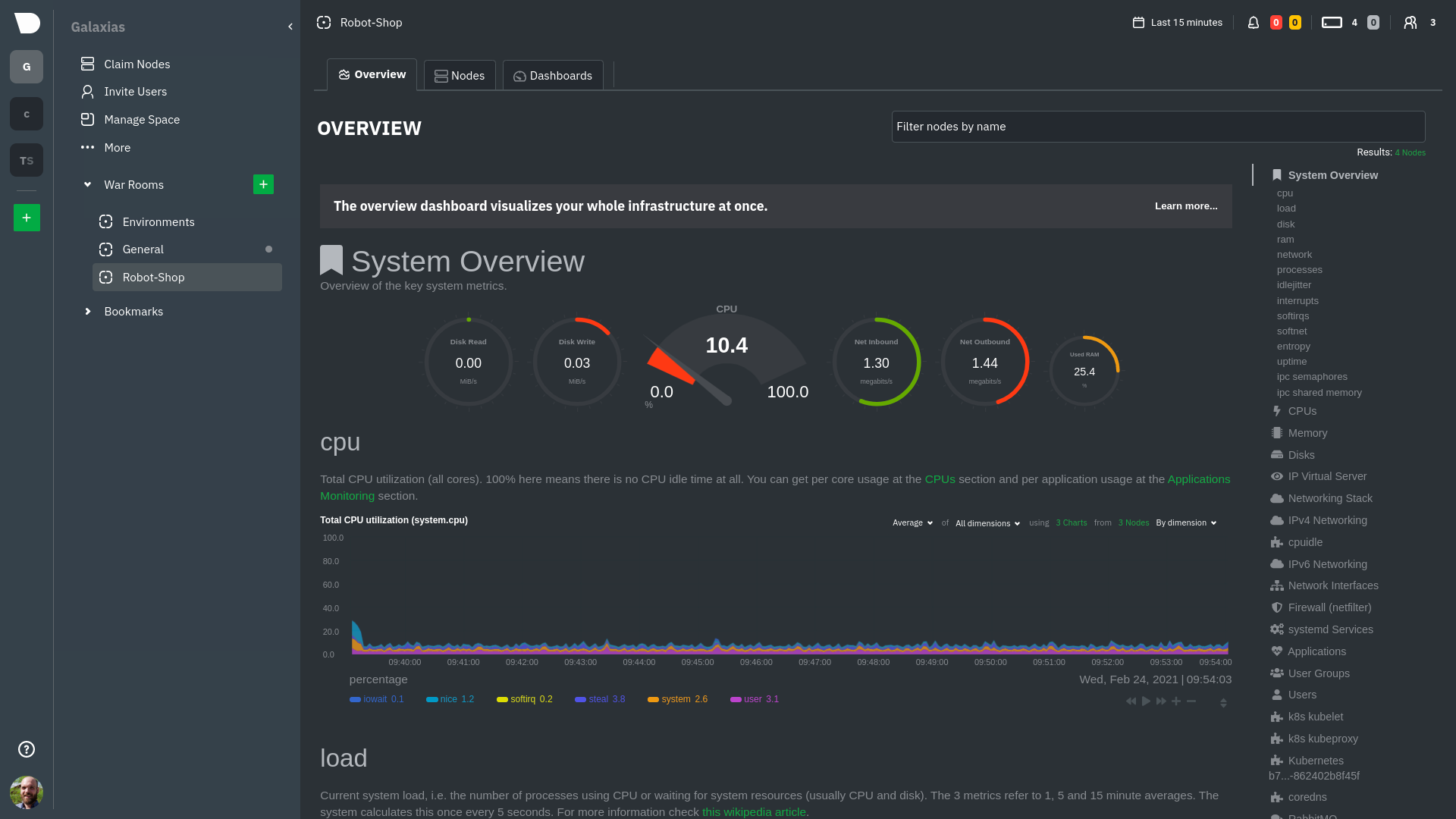
Let's walk through monitoring each layer of a Kubernetes cluster using the Overview as our framework.
## Cluster and node metrics
The gauges and time-series charts you see right away in the Overview show aggregated metrics from every node in your
cluster.
For example, the `apps.cpu` chart (in the **Applications** menu item), visualizes the CPU utilization of various
applications/services running on each of the nodes in your cluster. The **X Nodes** dropdown shows which nodes
contribute to the chart and links to jump a single-node dashboard for further investigation.
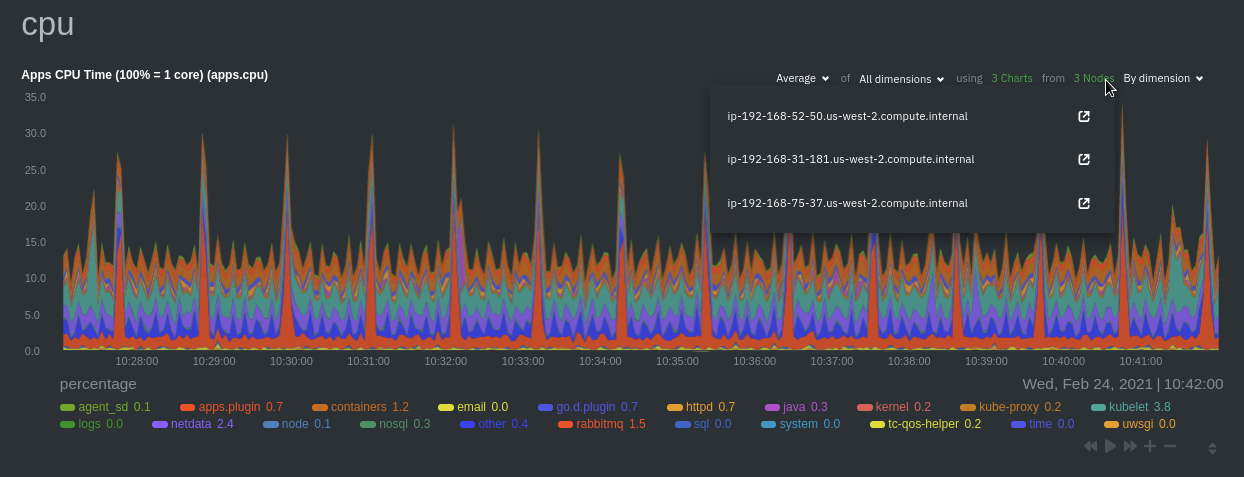
For example, the chart above shows a spike in the CPU utilization from `rabbitmq` every minute or so, along with a
baseline CPU utilization of 10-15% across the cluster.
Read about the [Overview](https://github.com/netdata/netdata/blob/master/docs/cloud/visualize/overview.md) and some best practices on [viewing
an overview of your infrastructure](https://github.com/netdata/netdata/blob/master/docs/visualize/overview-infrastructure.md) for details on using composite charts to
drill down into per-node performance metrics.
## Pod and container metrics
Click on the **Kubernetes xxxxxxx...** section to jump down to Netdata Cloud's unique Kubernetes visualizations for view
real-time resource utilization metrics from your Kubernetes pods and containers.
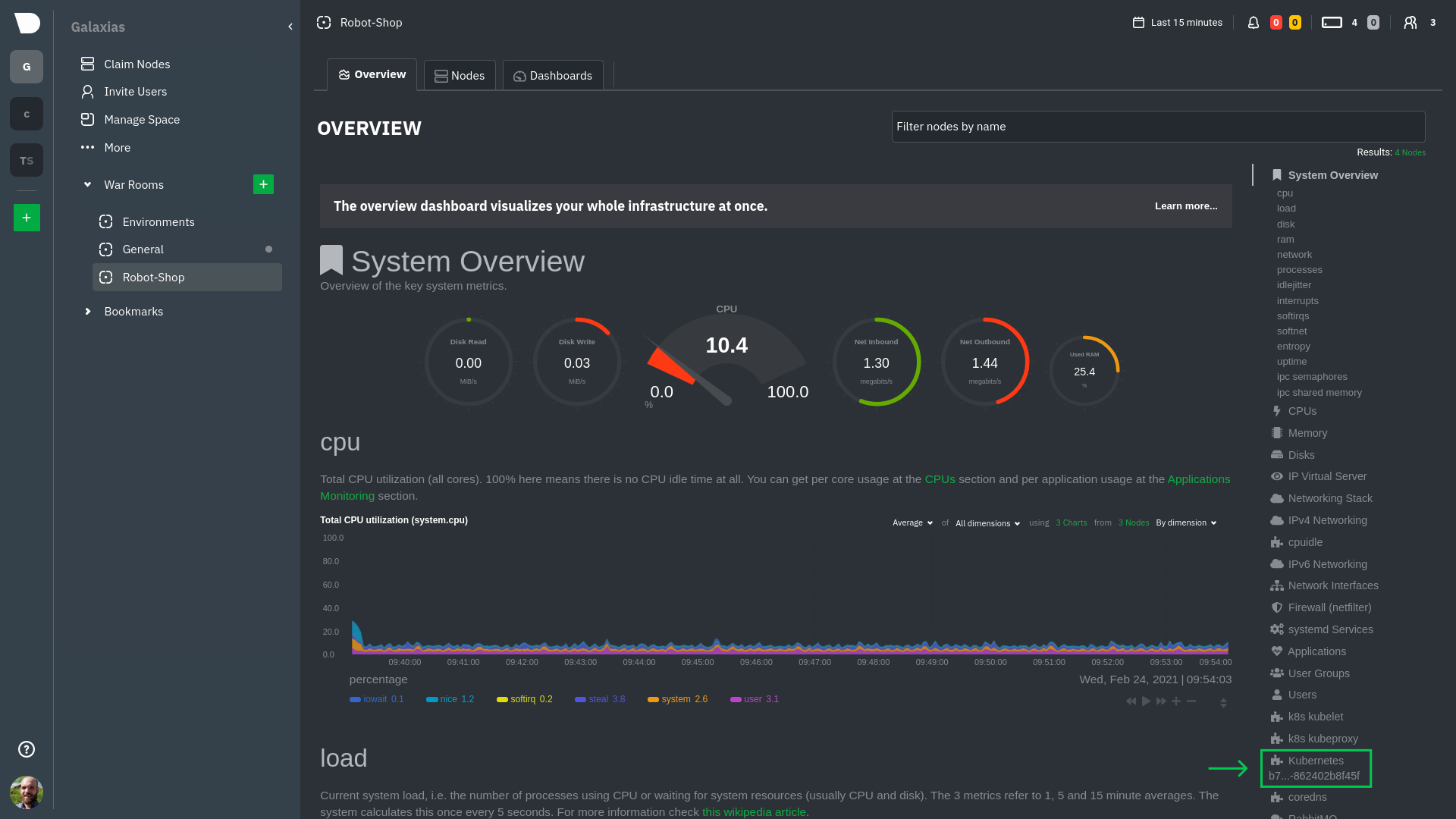
### Health map
The first visualization is the [health map](https://github.com/netdata/netdata/blob/master/docs/cloud/visualize/kubernetes.md#health-map),
which places each container into its own box, then varies the intensity of their color to visualize the resource
utilization. By default, the health map shows the **average CPU utilization as a percentage of the configured limit**
for every container in your cluster.
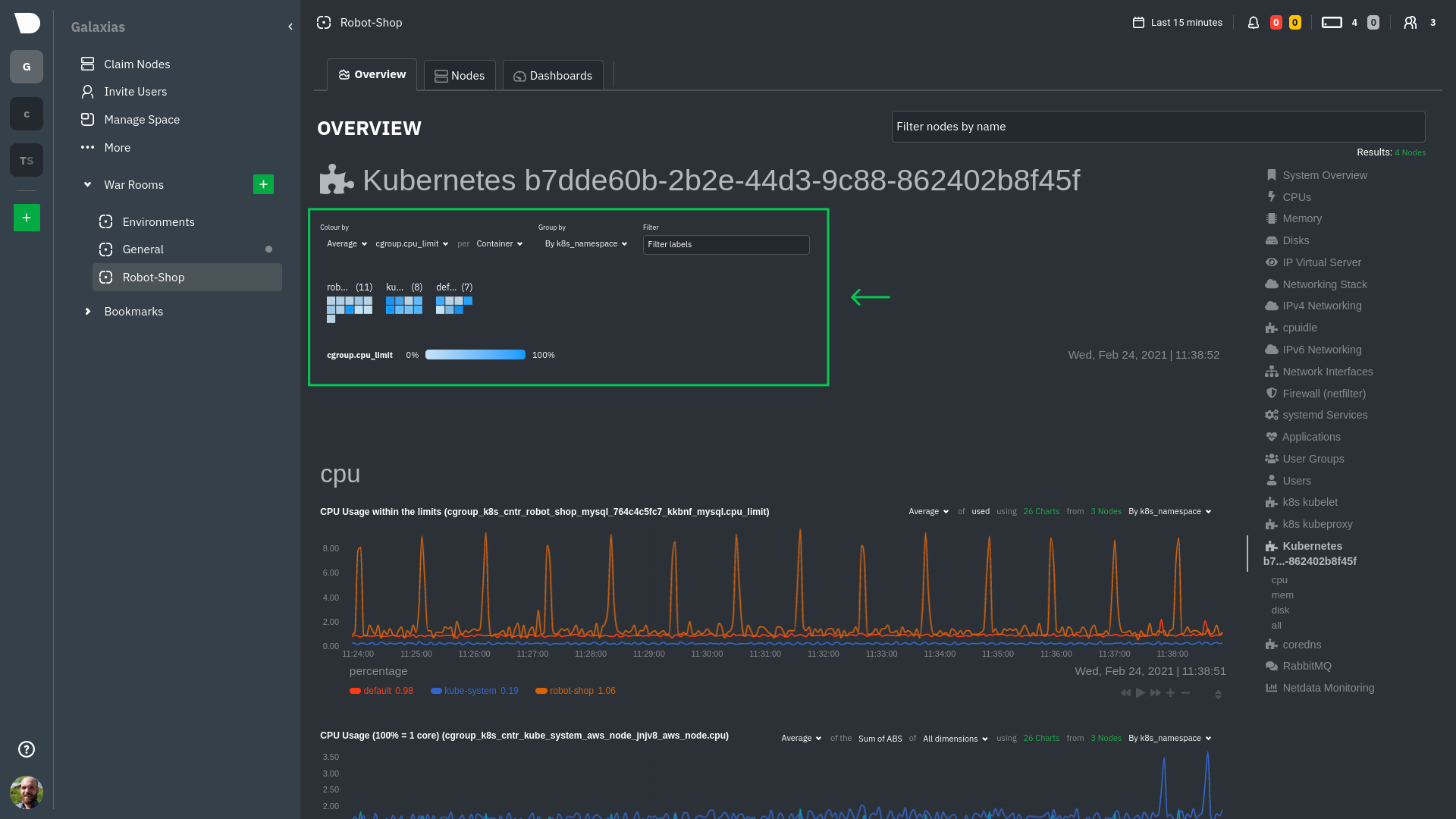
Let's explore the most colorful box by hovering over it.
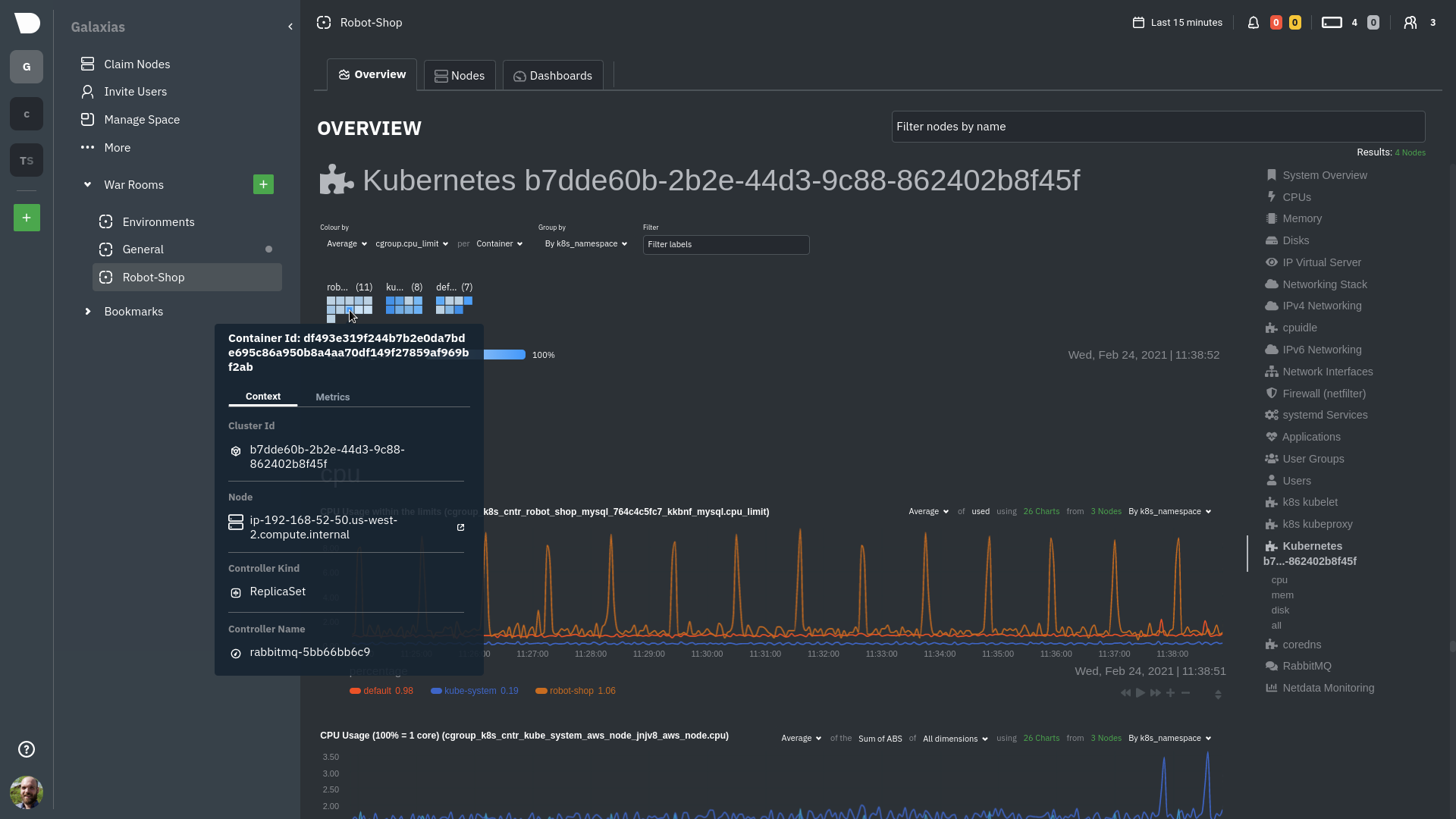
The **Context** tab shows `rabbitmq-5bb66bb6c9-6xr5b` as the container's image name, which means this container is
running a [RabbitMQ](https://github.com/netdata/go.d.plugin/blob/master/modules/rabbitmq/README.md) workload.
Click the **Metrics** tab to see real-time metrics from that container. Unsurprisingly, it shows a spike in CPU
utilization at regular intervals.
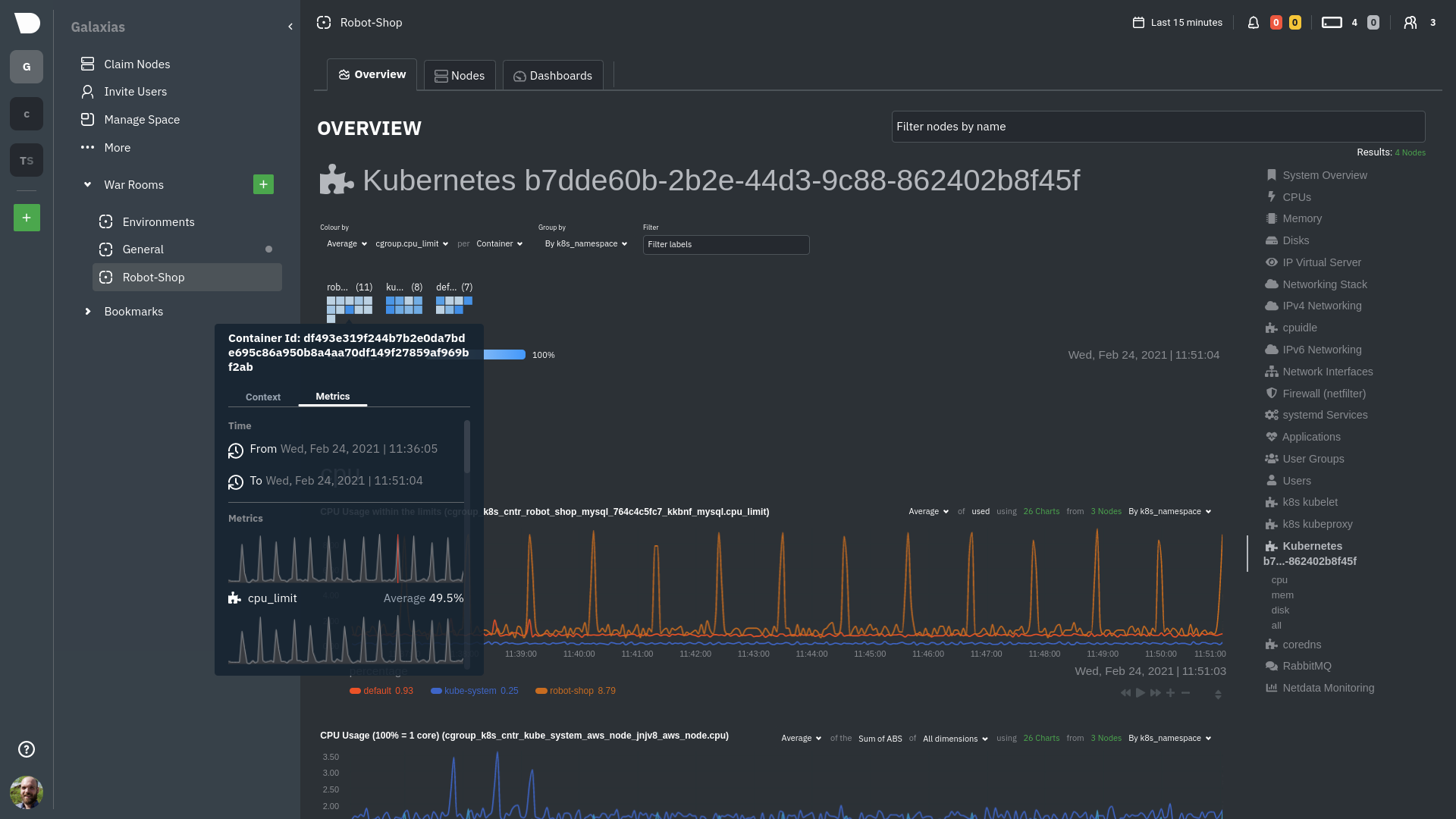
### Time-series charts
Beneath the health map is a variety of time-series charts that help you visualize resource utilization over time, which
is useful for targeted troubleshooting.
The default is to display metrics grouped by the `k8s_namespace` label, which shows resource utilization based on your
different namespaces.
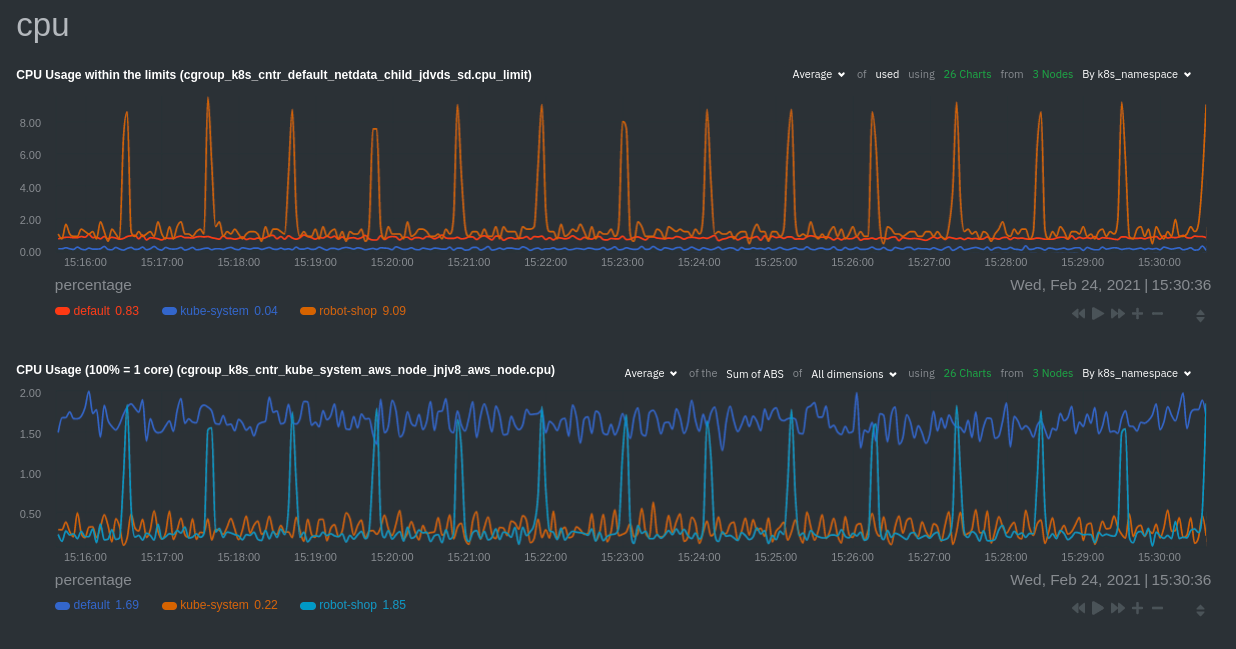
Each composite chart has a [definition bar](https://github.com/netdata/netdata/blob/master/docs/cloud/visualize/overview.md#definition-bar)
for complete customization. For example, grouping the top chart by `k8s_container_name` reveals new information.
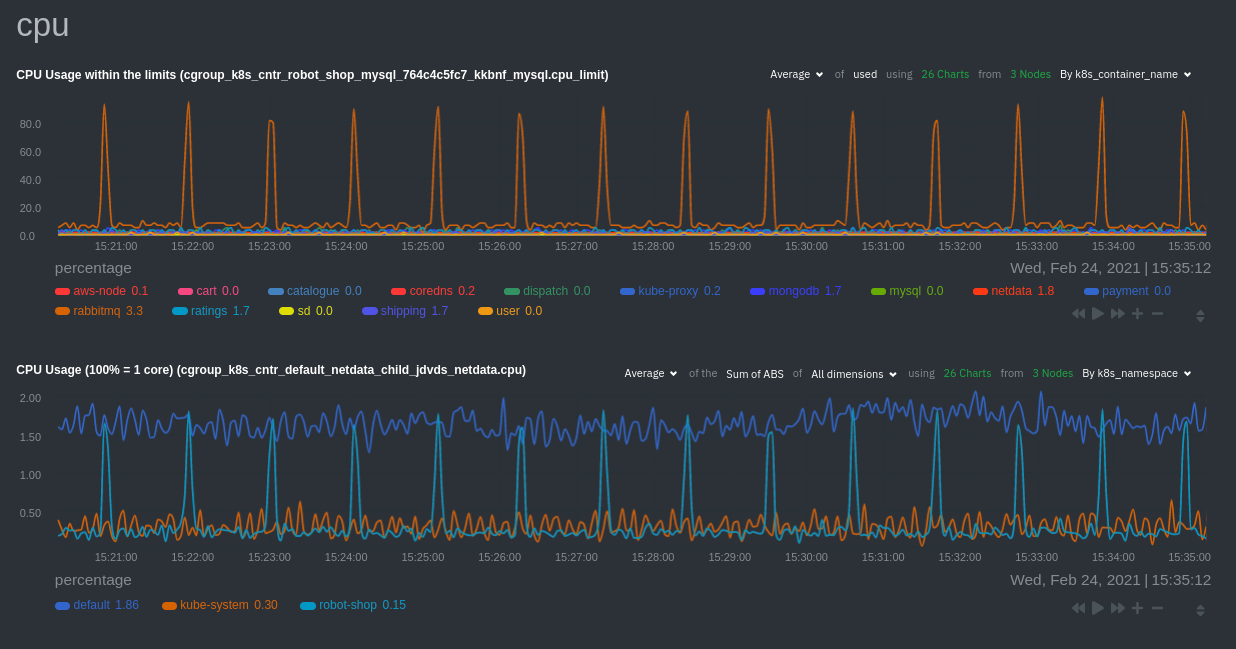
## Service metrics
Netdata has a [service discovery plugin](https://github.com/netdata/agent-service-discovery), which discovers and
creates configuration files for [compatible
services](https://github.com/netdata/helmchart#service-discovery-and-supported-services) and any endpoints covered by
our [generic Prometheus collector](https://github.com/netdata/go.d.plugin/blob/master/modules/prometheus/README.md).
Netdata uses these files to collect metrics from any compatible application as they run _inside_ of a pod. Service
discovery happens without manual intervention as pods are created, destroyed, or moved between nodes.
Service metrics show up on the Overview as well, beneath the **Kubernetes** section, and are labeled according to the
service in question. For example, the **RabbitMQ** section has numerous charts from the [`rabbitmq`
collector](https://github.com/netdata/go.d.plugin/blob/master/modules/rabbitmq/README.md):
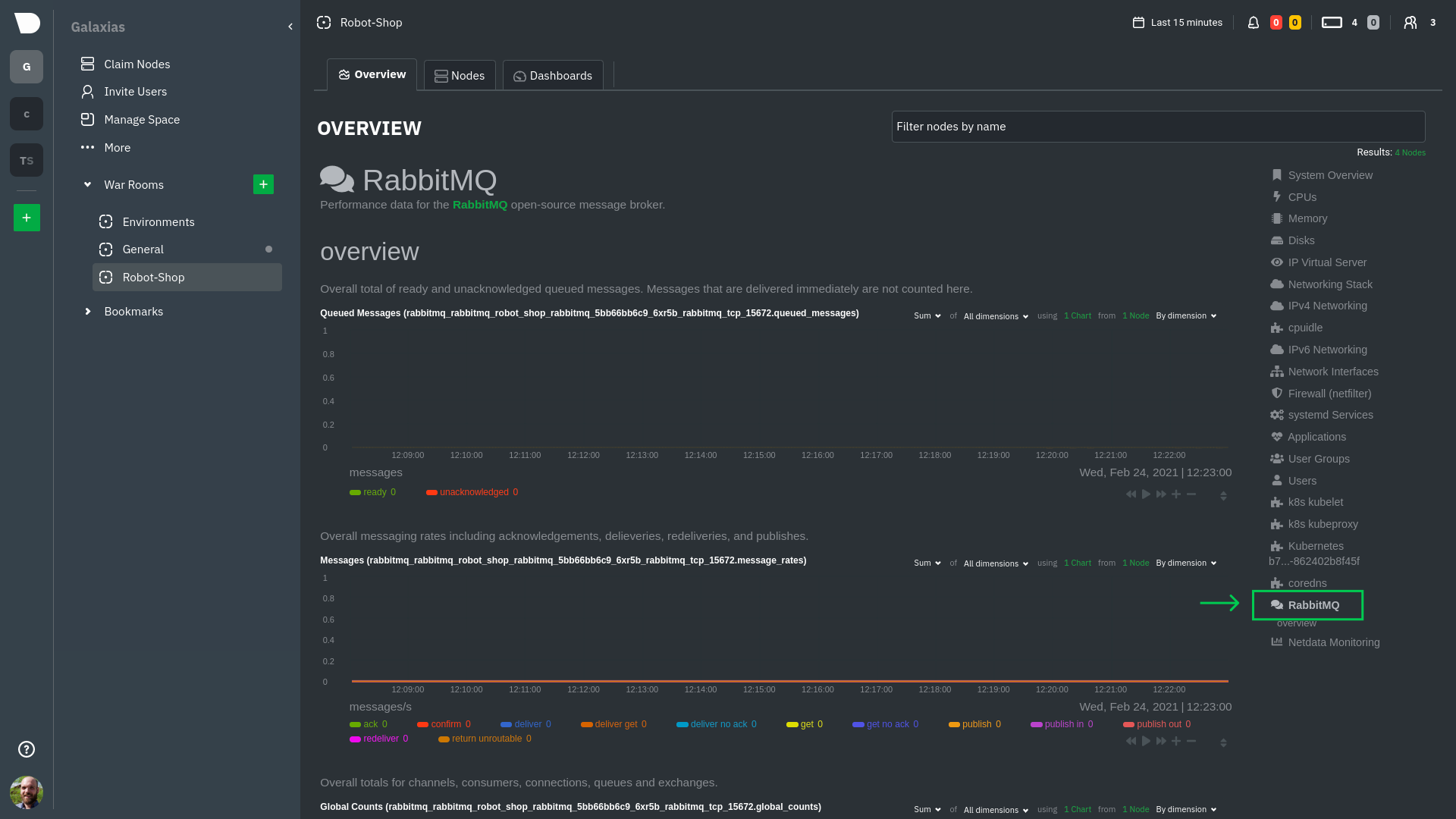
> The robot-shop cluster has more supported services, such as MySQL, which are not visible with zero configuration. This
> is usually because of services running on non-default ports, using non-default names, or required passwords. Read up
> on [configuring service discovery](https://github.com/netdata/netdata/blob/master/packaging/installer/methods/kubernetes.md#configure-service-discovery) to collect
> more service metrics.
Service metrics are essential to infrastructure monitoring, as they're the best indicator of the end-user experience,
and key signals for troubleshooting anomalies or issues.
## Kubernetes components
Netdata also automatically collects metrics from two essential Kubernetes processes.
### kubelet
The **k8s kubelet** section visualizes metrics from the Kubernetes agent responsible for managing every pod on a given
node. This also happens without any configuration thanks to the [kubelet
collector](https://github.com/netdata/go.d.plugin/blob/master/modules/k8s_kubelet/README.md).
Monitoring each node's kubelet can be invaluable when diagnosing issues with your Kubernetes cluster. For example, you
can see if the number of running containers/pods has dropped, which could signal a fault or crash in a particular
Kubernetes service or deployment (see `kubectl get services` or `kubectl get deployments` for more details). If the
number of pods increases, it may be because of something more benign, like another team member scaling up a
service with `kubectl scale`.
You can also view charts for the Kubelet API server, the volume of runtime/Docker operations by type,
configuration-related errors, and the actual vs. desired numbers of volumes, plus a lot more.
### kube-proxy
The **k8s kube-proxy** section displays metrics about the network proxy that runs on each node in your Kubernetes
cluster. kube-proxy lets pods communicate with each other and accept sessions from outside your cluster. Its metrics are
collected by the [kube-proxy
collector](https://github.com/netdata/go.d.plugin/blob/master/modules/k8s_kubeproxy/README.md).
With Netdata, you can monitor how often your k8s proxies are syncing proxy rules between nodes. Dramatic changes in
these figures could indicate an anomaly in your cluster that's worthy of further investigation.
## What's next?
After reading this guide, you should now be able to monitor any Kubernetes cluster with Netdata, including nodes, pods,
containers, services, and more.
With the health map, time-series charts, and the ability to drill down into individual nodes, you can see hundreds of
per-second metrics with zero configuration and less time remembering all the `kubectl` options. Netdata moves with your
cluster, automatically picking up new nodes or services as your infrastructure scales. And it's entirely free for
clusters of all sizes.
### Related reference documentation
- [Netdata Helm chart](https://github.com/netdata/helmchart)
- [Netdata service discovery](https://github.com/netdata/agent-service-discovery)
- [Netdata Agent · `kubelet`
collector](https://github.com/netdata/go.d.plugin/blob/master/modules/k8s_kubelet/README.md)
- [Netdata Agent · `kube-proxy`
collector](https://github.com/netdata/go.d.plugin/blob/master/modules/k8s_kubeproxy/README.md)
- [Netdata Agent · `cgroups.plugin`](https://github.com/netdata/netdata/blob/master/collectors/cgroups.plugin/README.md)
|
